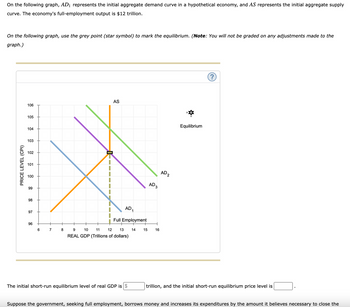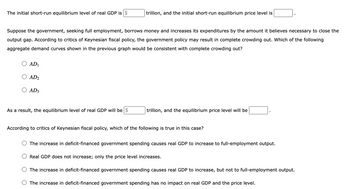
ENGR.ECONOMIC ANALYSIS
14th Edition
ISBN: 9780190931919
Author: NEWNAN
Publisher: Oxford University Press
expand_more
expand_more
format_list_bulleted
Question

Transcribed Image Text:On the following graph, AD1 represents the initial aggregate demand curve in a hypothetical economy, and AS represents the initial aggregate supply
curve. The economy's full-employment output is $12 trillion.
On the following graph, use the grey point (star symbol) to mark the equilibrium. (Note: You will not be graded on any adjustments made to the
graph.)
PRICE LEVEL (CPI)
AS
106
105
104
103
63
102
101
100
99
98
AD
AD
吕
1
97
96
Full Employment
96
6
7
8
9
10
11
12
13
14
15
16
REAL GDP (Trillions of dollars)
AD
2
Equilibrium
The initial short-run equilibrium level of real GDP is $
trillion, and the initial short-run equilibrium price level is
Suppose the government, seeking full employment, borrows money and increases its expenditures by the amount it believes necessary to close the

Transcribed Image Text:The initial short-run equilibrium level of real GDP is $
trillion, and the initial short-run equilibrium price level is
Suppose the government, seeking full employment, borrows money and increases its expenditures by the amount it believes necessary to close the
output gap. According to critics of Keynesian fiscal policy, the government policy may result in complete crowding out. Which of the following
aggregate demand curves shown in the previous graph would be consistent with complete crowding out?
AD1
AD2
AD3
As a result, the equilibrium level of real GDP will be $
trillion, and the equilibrium price level will be
According to critics of Keynesian fiscal policy, which of the following is true in this case?
The increase in deficit-financed government spending causes real GDP to increase to full-employment output.
Real GDP does not increase; only the price level increases.
The increase in deficit-financed government spending causes real GDP to increase, but not to full-employment output.
The increase in deficit-financed government spending has no impact on real GDP and the price level.
Expert Solution
This question has been solved!
Explore an expertly crafted, step-by-step solution for a thorough understanding of key concepts.
This is a popular solution
Trending nowThis is a popular solution!
Step by stepSolved in 2 steps

Knowledge Booster
Similar questions
- am. 19.arrow_forwardExplain how real GDP is determined when the price level is fixed.arrow_forwardInterpret the change you drew on the previous graph by filling in the blanks in the following paragraph: The lower-than-expected price level causes firms to earn more profit than they expected on each unit of output they produce, and, therefore, they decrease their production level. At the same time, the real value of wages and other resource prices are lower than workers and firms expected when they signed long-term contracts. As a result, the economy as a whole produces at a level below the unemployment rate is lower than its natural rate. its potential output, and Now, suppose prices remain lower than expected. As a result, in the next round of labor negotiations, unions accept lower wages for their members. The following graph shows the potential output for this economy as well as the same initial short-run aggregate supply curve as in the first graph. Shift one or both of these lines to illustrate how the economy adjusts to a new long-run equilibrium. PRICE LEVEL 180 SRAS 150…arrow_forward
- Economists forecast future economic conditions by studying variables that tend to fluctuate in advance of the overall economy. The most significant of these variables are known as leading indicators, and they compose the index of leading economic indicators. Which of the following variables are measured as part of this index? Check all that apply. Supplier deliveries The ratio of elderly to nonelderly workers New orders for consumer goods Stock prices The money supply True or False: Businesses and government care only about long-run economic forecasts, because they cannot adapt policy or output to accommodate short-run fluctuations. False True Suppose the most recent data show that the average initial weekly claims for unemployment insurance have recently decreased. This change suggests ____ period in the coming months.arrow_forwardhow do we answer this?arrow_forwardIn order to improve the living standards of the people in Philippines after the devastating typhoon Haiyan, the government decided to increase the labour wage per hour from AUD 17.50 to AUD 25.00. Also, Philippines experienced structural unemployment and frictional unemployment. The figure below indicates that the aggregate demand curve slopes left to right downwards. 1)Explain the factors that account for the shape of the Aggregate demand curve. Graph:arrow_forward
- Please answer all partsarrow_forwardConsider a fictional price index, the College Student Price Index (CSPI), based on a typical college student’s annual purchases. Suppose the following table shows information on the market basket for the CSPI and the prices of each of the goods in 2017, 2018, and 2019. The cost of each item in the basket and the total cost of the basket are shown for 2017. Perform these same calculations for 2018 and 2019, and enter the results in the following table. **THE TABLE IS ATTACHED** Suppose the base year for this price index is 2017. In the last row of the table, calculate and enter the value of the CSPI for the remaining years. Between 2017 and 2018, the CSPI increased by_________%. Between 2018 and 2019, the CSPI increased by_________%. Which of the following, if true, would illustrate why price indexes such as the CSPI might overstate inflation in the cost of going to college? Check all that apply. As the price of textbooks increased, more and more students…arrow_forwardConsider a fictional price index, the College Student Price Index (CSPI), based on a typical college student’s annual purchases. Suppose the following table shows information on the market basket for the CSPI and the prices of each of the goods in 2017, 2018, and 2019. The cost of each item in the basket and the total cost of the basket are shown for 2017. Perform these same calculations for 2018 and 2019, and enter the results in the following table.arrow_forward
- A futures market trades contracts on the growth rate for nominal GDP. The contract pays $X to the buyer, where X is 100 times the growth rate in nominal GDP from last year to this year. For example, if nominal GDP grows by 1% over last year, the contract pays $100 (1 x 100). Nominal GDP last year was $28,909 billion. Contracts on the futures markets are currently selling for $513. What is the market's prediction for nominal GDP this year? Put your answer in billions. You may round to two decimal places.arrow_forwardPrice Level LAS AS1 AD AS2 Real GDP Refer to the graph above to answer this question. If the economy was initially at point A, what would a movement to point B suggest? O The movement could be the result of an increase in nominal wages. The movement could be the result of an increase in prices. The movement could be the result of an increase in aggregate demand. The movement could be the result of increased government spending. The movement could be the result of a decrease in the costs of production.arrow_forwardIf one of the item in a simple aggregate price index is milk, the index will be unchanged if the price of milk is expressed in dollars per quart instead of dollars per gallon. In a Passche index, prices are weighted according to the quantities of the various items in the base period. The Consumer Price Index is a simple aggregate index.One application of the Consumer Price Index is to automatically increase wages or benefits through its inclusion in labor contracts. "Real income" refers to the amount money available after government taxes have been paid. The Producer Price Index measures changes in the physical volume or quantity of output of manufacturing, mining, and electric and gas utilities. TRUE OR FALSEarrow_forward
arrow_back_ios
SEE MORE QUESTIONS
arrow_forward_ios
Recommended textbooks for you

 Principles of Economics (12th Edition)EconomicsISBN:9780134078779Author:Karl E. Case, Ray C. Fair, Sharon E. OsterPublisher:PEARSON
Principles of Economics (12th Edition)EconomicsISBN:9780134078779Author:Karl E. Case, Ray C. Fair, Sharon E. OsterPublisher:PEARSON Engineering Economy (17th Edition)EconomicsISBN:9780134870069Author:William G. Sullivan, Elin M. Wicks, C. Patrick KoellingPublisher:PEARSON
Engineering Economy (17th Edition)EconomicsISBN:9780134870069Author:William G. Sullivan, Elin M. Wicks, C. Patrick KoellingPublisher:PEARSON Principles of Economics (MindTap Course List)EconomicsISBN:9781305585126Author:N. Gregory MankiwPublisher:Cengage Learning
Principles of Economics (MindTap Course List)EconomicsISBN:9781305585126Author:N. Gregory MankiwPublisher:Cengage Learning Managerial Economics: A Problem Solving ApproachEconomicsISBN:9781337106665Author:Luke M. Froeb, Brian T. McCann, Michael R. Ward, Mike ShorPublisher:Cengage Learning
Managerial Economics: A Problem Solving ApproachEconomicsISBN:9781337106665Author:Luke M. Froeb, Brian T. McCann, Michael R. Ward, Mike ShorPublisher:Cengage Learning Managerial Economics & Business Strategy (Mcgraw-...EconomicsISBN:9781259290619Author:Michael Baye, Jeff PrincePublisher:McGraw-Hill Education
Managerial Economics & Business Strategy (Mcgraw-...EconomicsISBN:9781259290619Author:Michael Baye, Jeff PrincePublisher:McGraw-Hill Education


Principles of Economics (12th Edition)
Economics
ISBN:9780134078779
Author:Karl E. Case, Ray C. Fair, Sharon E. Oster
Publisher:PEARSON

Engineering Economy (17th Edition)
Economics
ISBN:9780134870069
Author:William G. Sullivan, Elin M. Wicks, C. Patrick Koelling
Publisher:PEARSON

Principles of Economics (MindTap Course List)
Economics
ISBN:9781305585126
Author:N. Gregory Mankiw
Publisher:Cengage Learning

Managerial Economics: A Problem Solving Approach
Economics
ISBN:9781337106665
Author:Luke M. Froeb, Brian T. McCann, Michael R. Ward, Mike Shor
Publisher:Cengage Learning

Managerial Economics & Business Strategy (Mcgraw-...
Economics
ISBN:9781259290619
Author:Michael Baye, Jeff Prince
Publisher:McGraw-Hill Education